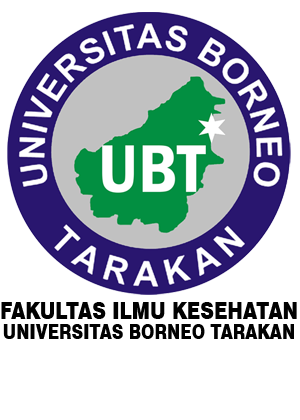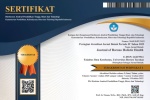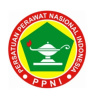PEMBERIAN TERAPI EXTERNAL COOLING PASIEN DEMAM AKIBAT SEPSIS BERAT ATAU SYOK SEPSIS DI INSTALASI GAWAT DARURAT
Abstract
Background: Â
Demam merupakan respon alami dari dalam tubuh yang bermanfaat dalam melawan infeksi akan tetapi demam ini juga dapat membahayakan tubuh apabila tidak dikontrol. Demam pada pasien dengan sepsis berat atau syok sepsis dapat menyebabkan dysregulated respon inflamasi.
Methods:
Metode yang digunakan dalam literature review ini adalah mengumpulkan dan melakukan analisa textbook dan artikel yang terkait dengan pemberian terapi external cooling pada pasien demam dengan penyebab sepsis berat atau syok sepsis. Sumber literature review ini diperoleh dari textbook dan artikel elektronik seperti ScienceDirect; World Health Organisation, Google Scholar, PubMed dan ClinicalKey dengan kriteria textbook dan artikel yang dipublikasi selama periode 2000-2015.
Results:
Pemberian terapi external cooling pada pasien demam akibat sepsis berat atau syok sepsis dilakukan dengan menggunakan cooling blankets atau selimut air-circulating cooling, seka (sponge baths), water blankets atau wraps ice packs, atau cooling pads dengan kecepatan pendinginan sampai dengan 1,5οC per jam untuk mencapai target temperatur 33 OC atau 32-34 OC. Pada saat proses ini kondisi pasien di observasi agar tidak terjadi shivering dan dilakukan pemeriksaan elektrolit, BGA dan EKG setiap 6 jam. Apabila telah dilakukan external cooling selama 24 jam atau lebih segera rewarming dengan kecepatan 0,2οC-0,33οC per jam selama 8 jam atau > 12 jam dengan diikuti pemeriksaan laboratorium, vital sign, EKG dan pencegahan terjadinya shivering. Observasi secara ketat tetap dilakukan untuk mencegah terjadinya efek samping dari eksternal cooling.
Conclusions:
External cooling merupakan salah satu terapi yang memberikan efek protektif dengan memodulasi respon inflamasi dan mensupresi reaksi inflamasi, menghambat pembentukan apoptosis, menghambat terbentuknya radikal bebas, menghambat agregrasi platelet, menurunkan kecepatan metabolisme dan menghambat pertumbuhan endotoksin pada pasien demam akibat sepsis atau syok sepsis
Kata kunci: Terapi External Cooling, Demam, Sepsis, Instalasi Gawat DaruratÂ
Full Text:
PDF (Bahasa Indonesia)References
Huet. (2007). The Cooling And Surviving Septic Shock Study. Acta Anaesthesiol Scandinavia journal
Jaitovich. (2013). Fever Control Using External Cooling in Septic Shock. American Journal Of Respiratory And Critical Care Medicine, 1273.
Johansen, Jensen, Bestle, Ostrowski, Thormar, Christensen, . . . Mohr. (2015). Mild Induced Hypothermia: Effects on Sepsis-related Coagulopathy results from a Randomized Controlled Trial. Thrombosis Research 135, 175-182. doi: http://dx.doi.org/10.1016/j.thromres.2014.10.028
Kupchik. (2009). Development and Implementation of a Therapeutic Hypothermia Protocol. Critical Care Medicine, 37(7), 279-284. doi: 10.1097/CCM.0b013e3181aa61c5
Lakshmanan, Sadaka, Palagiri, Samaniego, & Tannehill. (2013). Therapeutic Hypothermia In Brain Injury. 4, 14.
Launey, Nesseler Mallédant, Philippe Segui. Clinical review: Fever in Septic ICU patients - friend or foe? Critical Care 2011, 15:222 doi: 10.1186/cc10097. BioMed Central Ltd
Li, Liu, Li, Jin, Luo, Fei-fei, Li, Lin, Zhu, & Xie, Qilian. (2015). Accompanying Mild Hypothermia Significantly Improved the Prognosis of Septic Mice than Artificial Mild Hypothermia. American Journal of Emergency Medicine, 33, 1651-1658. doi: http://dx.doi.org/10.1016/j.ajem.2015.08.003
Moore, Nichol, Bernard, & Bellomo. (2011). Therapeutic Hypothermia: Benefits, Mechanisms and Potential Clinical Applications in Neurological, Cardiac and Kidney Injury. Int. J. Care Injured, 42, 843-854. doi: 10.1016/j.injury.2011.03.027
O’Grady, Philip S. Barie. John G. Bartlett, Thomas Bleck, Karen Carroll, Andre C. Kalil, Peter Linden, Dennis G. Mak, David Nierman. Guidelines for Evaluation of New Fever in Critically Ill Adult Patients: 2008 Update from The American College of Critical Care Medicine and the Infectious Diseases Society of America. Crit Care Med 2008 Vol. 36, No. 4. William & Wilkins
Rim, Pil, Kim, Jo, Hwan, Lee, Hyuk, Rhee, Eui, Kang, Won, . . . Lee, Sook. (2012). Effect of Therapeutic Hypothermia According to Severity of Sepsis in a Septic Rat Model. Cytokine, 60, 755-761. doi: http://dx.doi.org/10.1016/j.cyto.2012.08.013
Russell. (2012). Control of Fever in Septic Shock: Should We Care or Intervene? American Thoracic Society, 1004. doi: 10.1164/rccm.201202-0346ED
Sadaka. (2013). Therapeutic Hypothermia in Brain Injury. www.intechopen.com. doi: //dx.doi.org/10.5772/3380
Saltzberg. (2013). Fever and Signs of Shock The Essesntial Dangerous Fever. Emergency Medicine Clin N AM 31, 907-926. doi: dx.doi.org/10.1016/j.emc.2013.07.009
Shime. (2013). Does Cooling Really Improve Outcomes in Patients with Septic Shock? American Journal Of Respiratory And Critical Care Medicine, 187, 1274-1276.
Schortgen F, Clabault K, Katsahian S, Devaquet J, Mercat A, Deye N, Dellamonica J, Bouadma L, Cook F, Beji O, et al. Fever Control Using External Cooling in Septic Shock: a randomized Controlled Trial. Am J Respir Crit Care Med 2012; 185: 1088– 095
Young, & Saxena. (2014). Fever Management in Intensive Care Patients with Infections. Critical Care, 18, 206.
Zaaqoq, & Yende. (2013). A Touch of Cooling may help. Journal Club Critique, 17, 307.
DOI: https://doi.org/10.35334/borticalth.v1i2.465
Refbacks
- There are currently no refbacks.









